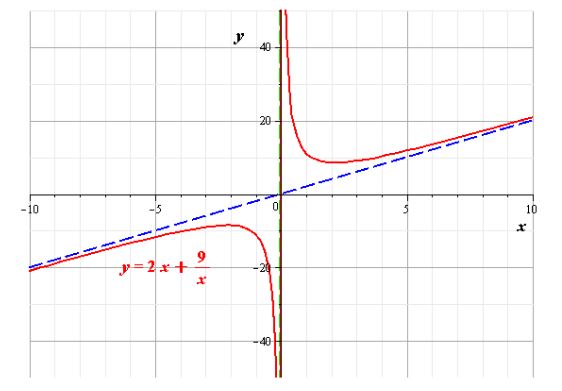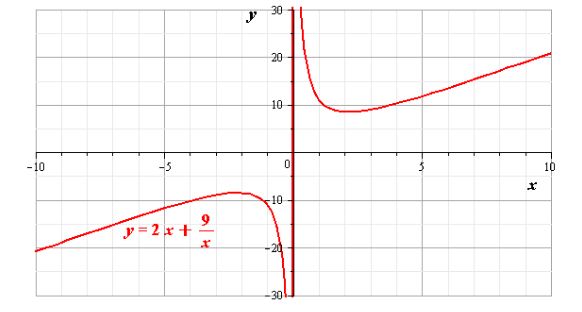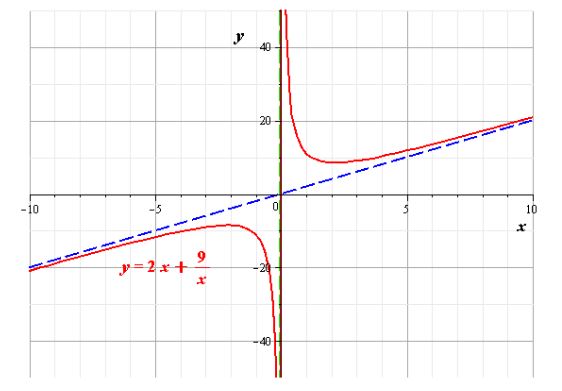
Concept explainers
To analyze: the graph of given function
Answer to Problem 40AYU

Explanation of Solution
Given:
Calculation:
Here, we have to analyze the graph of the rational function
Let us consider it as
Too, so that it will be easy to graph it on the Cartesian plane.
This can be done simply in a few steps. Let us do it.
Step1: We will factorize the numerator and denominator and find the domain of the rational function. Therefore,
Step2: Now, we will write
Step3: We have to find the intercepts on the graph. The x intercept can be found by determining the real zeroes of the numerator of
No real solutions.
The y intercept can be found by determining the value of
Step4: Let us now test for the symmetry of the graph. A graph is symmetric about
From this, we conclude that there is symmetry with respect to with
Step5: Now, we will locate the vertical asymptotes. This is done by finding the zeroes of the denomination of the rational function in lowest terms. With R in the lowest terms we find that the graph of
Step6: Now let us locate any horizontal or oblique asymptote and determine the point if any which intersect the asymptotes at any point.
There is no horizontal asymptote of the graph. Let us calculate the oblique asymptotes. This can be found by dividing the numerator by denominator and the part except the remainder is the asymptote.
In
Therefore, the polynomial has oblique asymptote as
Step7: Now let us graph

Step8: Now let us use the results we have from step 1 to 7 and the make the final graph by hand. The graph for this can be shown as:

Conclusion:
Thus, the graph of
Chapter 4 Solutions
Precalculus
Additional Math Textbook Solutions
University Calculus: Early Transcendentals (4th Edition)
Pre-Algebra Student Edition
Intro Stats, Books a la Carte Edition (5th Edition)
Elementary Statistics (13th Edition)
College Algebra (7th Edition)
- A 20 foot ladder rests on level ground; its head (top) is against a vertical wall. The bottom of the ladder begins by being 12 feet from the wall but begins moving away at the rate of 0.1 feet per second. At what rate is the top of the ladder slipping down the wall? You may use a calculator.arrow_forwardExplain the focus and reasons for establishment of 12.4.1(root test) and 12.4.2(ratio test)arrow_forwarduse Integration by Parts to derive 12.6.1arrow_forward
- Explain the relationship between 12.3.6, (case A of 12.3.6) and 12.3.7arrow_forwardExplain the key points and reasons for the establishment of 12.3.2(integral Test)arrow_forwardUse 12.4.2 to determine whether the infinite series on the right side of equation 12.6.5, 12.6.6 and 12.6.7 converges for every real number x.arrow_forward
- use Corollary 12.6.2 and 12.6.3 to derive 12.6.4,12.6.5, 12.6.6 and 12.6.7arrow_forwardExplain the focus and reasons for establishment of 12.5.1(lim(n->infinite) and sigma of k=0 to n)arrow_forwardExplain the focus and reasons for establishment of 12.5.3 about alternating series. and explain the reason why (sigma k=1 to infinite)(-1)k+1/k = 1/1 - 1/2 + 1/3 - 1/4 + .... converges.arrow_forward
 Calculus: Early TranscendentalsCalculusISBN:9781285741550Author:James StewartPublisher:Cengage Learning
Calculus: Early TranscendentalsCalculusISBN:9781285741550Author:James StewartPublisher:Cengage Learning Thomas' Calculus (14th Edition)CalculusISBN:9780134438986Author:Joel R. Hass, Christopher E. Heil, Maurice D. WeirPublisher:PEARSON
Thomas' Calculus (14th Edition)CalculusISBN:9780134438986Author:Joel R. Hass, Christopher E. Heil, Maurice D. WeirPublisher:PEARSON Calculus: Early Transcendentals (3rd Edition)CalculusISBN:9780134763644Author:William L. Briggs, Lyle Cochran, Bernard Gillett, Eric SchulzPublisher:PEARSON
Calculus: Early Transcendentals (3rd Edition)CalculusISBN:9780134763644Author:William L. Briggs, Lyle Cochran, Bernard Gillett, Eric SchulzPublisher:PEARSON Calculus: Early TranscendentalsCalculusISBN:9781319050740Author:Jon Rogawski, Colin Adams, Robert FranzosaPublisher:W. H. Freeman
Calculus: Early TranscendentalsCalculusISBN:9781319050740Author:Jon Rogawski, Colin Adams, Robert FranzosaPublisher:W. H. Freeman
 Calculus: Early Transcendental FunctionsCalculusISBN:9781337552516Author:Ron Larson, Bruce H. EdwardsPublisher:Cengage Learning
Calculus: Early Transcendental FunctionsCalculusISBN:9781337552516Author:Ron Larson, Bruce H. EdwardsPublisher:Cengage Learning





